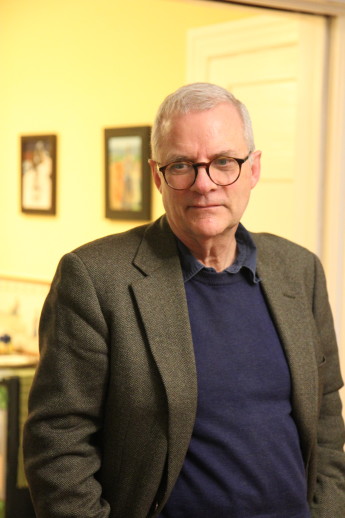A need to tell and hear stories is essential to the species Homosapiens — second in necessity apparently after nourishment and before love and shelter. Millions survive without love or home, almost none in silence; the opposite of silence leads quickly to narrative, and the sound of story is the dominant sound of our lives, from the small accounts of our days’ events to the vast incommunicable constructs of psychopaths. – Reynolds Price
Al McKee
Al McKee is head writer at Studio O+A in San Francisco.

Why do architects need storytellers?
I think design naturally gravitates toward narrative. The choices a designer or an architect makes about shaping space and orchestrating light and making use of color—all those things settle into a theme. If they didn’t, they’d be arbitrary and pointless. What designers have come to understand is that the more developed that theme is, the stronger the design will be.
We’re a storytelling species—right? We surround ourselves with stories, and we feel most comfortable in the stories we love. Why is your favorite room in the house your favorite? Is it because it meets some classical definition of good architecture, or is it because the windows bring sunlight in in a way that reminds you of childhood summers? Maybe it’s the hardwood floor against your feet. Maybe it’s the bookshelves. Whatever it is, it’s probably your favorite because the room tells you a story about your life that speaks to the person you want to be.
A design firm needs storytellers to help discover the stories that speak to their clients. My role at O+A is to spell those stories out in client presentations, RFP responses, marketing materials, press releases, etc.—but every designer in our firm is, to some extent, a storyteller.
How have the stories that architects tell changed in the last few years?
They’ve become more complex, more sophisticated. I’m speaking here of workplace design, which is what O+A specializes in. If you look at what office environments were 20 years ago and what they are today, it’s clear the stories have changed. The old cubicle farms told one story—across all industries, across all cultures. It was: “Get to work!” Now you look at an office and you get a sense of the spirit of the place, what the enthusiasms are, what the history is.
And I think designers have developed a more subtle vocabulary for telling stories architecturally. We recently did a series of offices for Yelp in San Francisco that are meant to evoke a few of the cities in which Yelp has a significant presence. Twenty years ago, if you were going to design a space to reflect a specific region, you’d do it literally—pagoda shapes in the Asian-inspired office, minaret graphics on the Turkish floor. But these new Yelp offices don’t do that. In the space inspired by Tokyo, all the details are directly linked to some aspect of Japanese culture or design, but nothing in the space is identifiably Japanese. So the story here is a backstory that lends shape and coherence to the design, but doesn’t overpower it. I think the users of these spaces feel that continuity even when they don’t know the story.
What stories interest clients and users of buildings?
I’m fascinated by how important history is to our clients. Many of the new tech entrepreneurs are keen on linking their forward-looking operations to brick and mortar traditions—sometimes literally brick and mortar. In the Bay Area, companies that are shaping the future often set up shop in old warehouses or industrial spaces. And they want to know the history of those spaces. Our brand studio usually begins a project by researching the history of the site, the history of the industry that preceded the current client in the space. There’s a real hunger in our technology-based culture for connection to what has come before. We all like to think of ourselves as part of an ongoing story—we want to move forward, but we respect our grandparents, and we don’t want to live in a world that’s completely alien to our grandparents’ values.
One way to maintain that link is storytelling. If your work is to sit at a computer all day, it helps to do so in a building that used to make rope—and to know the story of the rope-making plant, who the people were, what their hardships and aspirations were. These stories are of great interest to the people who are building new businesses. And many of them want to see those stories front and center in the design.
Any other thoughts?
I am fortunate to work for people who value storytelling as an integral part of the design process. O+A produces its own books. We maintain our website as a kind of online design magazine. Our principals speak about design—tell design stories—at forums all over the world. I think this is one reason why design is such an exciting profession right now. When our designers sit down with a client for that first meeting, it’s not just a conversation about where people are going to sit or what color the paint is going to be—it’s a story conference. It’s an exercise in “tell me who you are.”
John Parman
John Parman is the editorial director of Gensler Firmwide Communications. He also cofounded and published the quarterly Design Book Review (1983–1999).
 Architects have always told stories about their work. When I was asked to write my first architecture-related proposal at SOM, I found that its collected stories about its projects focused consistently on their use of flamed granite cladding. These stories were useless for my task of pitching the firm to public and institutional clients, but testified to the unimportance of text to the developers that made up their main clientele in the 1980s.
Architects have always told stories about their work. When I was asked to write my first architecture-related proposal at SOM, I found that its collected stories about its projects focused consistently on their use of flamed granite cladding. These stories were useless for my task of pitching the firm to public and institutional clients, but testified to the unimportance of text to the developers that made up their main clientele in the 1980s.
Also at SOM I once watched as the head design partner held an audience of visiting Japanese curtainwall manufacturers spellbound with his unabashed enthusiasm for this building component, down to its most arcane technical details. Quarry owners may have warmed similarly to the flamed granite references—certainly visiting the quarries in Italy and Spain was one of the perks for the SOM designers in this period.
This is a long way of saying that architects need storytellers who will help them reach audiences beyond their natural ones. Architects have coteries of clients, peers, and/or colleagues with whom they share a common language and interests. Reaching others is the challenge. One reason I use outside writers is because they get stories that may be seen by individual practitioners, but are woven into a larger narrative that puts the emphasis elsewhere. Sometimes, at a practitioner’s suggestion, the writers will also speak with people on the client side with a different take. “Write up what seems most interesting,” I tell them. “Don’t worry about the length.”
I work for a firm that’s focused on its clients and takes a genuine interest in the issues that concern them, recognizing their importance to the work at hand. The way the firm’s architects talk about the work speaks to their interest in finding common ground with their counterparts on the client side. Facilitating and translating is part of this, helping clients negotiate the fluid world in which buildings and settings take shape. But design is also a conversation among different parties, each seeking in some sense to own the narrative. Speaking the same language as the client is, for the architects, a way to share ownership of the client’s narrative rather than trying to supplant it.
Of course, stories relevant to clients are not necessarily of interest to other audiences, including architects themselves. Attracting talented architects to a firm means making it clear, one way or another, that they will find the work and people compatible. So stories need to be told—within and outside the firm—that convey this message. The truism that “the work speaks for itself” is true in the sense that architects gravitate toward work that resonates with them aesthetically. Given the cultural importance of design in many urban markets, this is often true for clients, too, but they may be less interested in theory, technique, and materiality.
The stories have to be true for the audience to which they’re directed, but in this world of instant communication, you have to account for leakage. A client may in all sincerity proclaim its new space “innovative,” providing a valuable anecdote to use when pursuing other clients of that type, but for others, the claim may be risible. The minefields of politics and popular culture are good to keep in mind, because their stock in trade is exposing conflicting stories and stories that invite ridicule.
So I would say that the stories had better be true for a broad audience, and told in a way that doesn’t turn one audience off by appearing to pander to another. There’s a school of thinking that runs through the theoretical and curatorial parts of the field, a variation on art for art’s sake, that finds clear explanation demeaning. If Foucault could write lucidly and accessibly, architects shouldn’t be embarrassed to do so. (Lars Lerup’s After the City comes to mind as a model for how to do this.)
I admit, though, to be a fan of books like Jean-François Lyotard’s The Postmodern Condition and Jill Stoner’s Toward a Minor Architecture, which blaze polemically from topic to topic. I like them because they really are art—admirable as writing, not just as argument. Similarly, when I find a monograph on architecture that holds my attention, the best text is either a brief, context-setting essay or even briefer annotations to the work.
Tim Culvahouse
Tim Culvahouse is a writer and storyteller. His firm is CulvaHOUSE in Berkeley, California.
Why do architects need storytellers? 
People need storytellers, and architects are, typically, people. But there are more specific reasons. One is that storytelling is a skill, and, like any skill, it’s not one that everybody possesses. Architects have many skills—arguably a greater number of skills than most professionals—so it’s a lot to expect them to have this one, too.
A second and more fundamental reason is that buildings are difficult to understand, except in person, but most explanations of buildings are proffered remotely—in magazines, newspapers, blogs, and so on. I like to say (because it’s fun to say, and also there’s some truth to it) that there are three kinds of lies: lies, damned lies, and pictures of buildings. But a friend of mine in graduate school, Richard Munday, was more precise: I had offered up the old saw that a picture is worth a thousand words, and Richard replied (imagine an Australian accent), “Hell, a picture is worth a million words. The trouble is, so few of them are germane.” There’s an infinite amount of information in a photograph of a building, and someone coming to it cold is unlikely to zero in on what the architect thinks is important. “Note the soffit detail” is rarely a sufficient prompt.
Also, stories do things that facts don’t and that arguments don’t. Many years ago, I visited the Steelcase headquarters in Grand Rapids, where I had the pleasure of dining at Frank Lloyd Wright’s Meyer May House, which Steelcase owns. It’s one of the prairie-style houses; the dining table has posts with lamps at the corners, with philodendrons in dishes, and the chairs are those ramrod-straight, high-backed ones that suggest a vaguely ecclesiastical, disciplinary function. It was a long, luxurious, delicious dinner, prepared by their resident chef, and the eight of us talked for—what? two hours? three?—without the conversation ever breaking up into tête-à-têtes. Since then, I don’t argue with people about whether those chairs are comfortable or not. I just tell this story.
What stories interest clients and users of buildings?
I was going to say, “For over simplicity’s sake, I’ll divide clients into two sorts: the sort who hire an architect because they want a building, and the sort who hire an architect because they want to be known as somebody who hires an architect. The latter may be interested in stories about what the architect was thinking or how she went about generating the form, but the former is not.” But I take it back.
Here’s what I really think: the reason we learn the characteristics of a cabernet franc or the career statistics of a baseball player is so that we can enjoy those experiences—of wine, of baseball—more. Same with buildings: anyone’s going to be interested in anything that deepens their enjoyment. For some clients, that will include stories about the architect’s philosophy and method. For others—I would say for most—it will include any story that leads them to the building’s richest experiences. “Sit here. You see?”
Any other thoughts?
Nope.
Molly Thomas
Molly Thomas is the communications director for WRNS in San Francisco.
Why do architects need storytellers? 
This may seem random, but let’s start with one of those “Shot on the iPhone 6” posters—that one with the surfer sitting next to his little red Datsun with the ocean before him: it takes me to some eternal lazy weekend, or better yet, that childhood camping trip to Leo Carrillo with those sinewy long-haired boys and the smell of BBQ. Snap, share, save. That’s all I need. And the iPhone 6 is so seamless and beautiful, timeless like this moment before the sea.
Someone at Apple knows you need to strike hard at the human condition, getting at memory and desire. Render a simple but strong experience or feeling, drawn from a complex and rich underlay, and we’re hooked. The need for this kind of storytelling in architecture is no different, only the stakes are so much higher. Place is about as personal and fundamental to the human condition as it gets; we actually need it, and we do things better as individuals and a collective when it is done well. People—those who take the financial risk in hiring us, those who will inhabit the building, and the community that will be impacted by its presence on the street—need to know that we “get it.” And “it” is usually some mesh of identity, place, culture, aspiration, and financial or time constraints. Ferreting out the “it” and translating it into a resonant human experience requires story.
How have the stories that architects tell changed in the last few years?
Wider use of social media and blogs has made it much easier for architects to share their stories, illuminating their culture and predilections and tying them to a larger social or intellectual discourse. This is good on so many levels—connecting with your network, amplifying your brand, and recruiting. A quick read of Lake Flato’s blog, for instance, tells me that they’re a tight community full of personality and that their sustainability story is often about a “thermal break.” There’s an apparent level of specificity and craft, which would have otherwise stayed in people’s heads or remained buried in design narratives deep in the hard drive. Teasing out these kind of stories that already exist within the studio and sharing them—increasingly within our own publishing platforms—is the job of the storyteller.
In terms of life at WRNS, storytelling hasn’t changed much. It’s in our DNA. During my first interview more than 10 years ago, one of our founding partners, Sam Nunes, asked me if I was more Hemingway or Faulkner (my response was direct and declarative, if not entirely true, as it seemed to be a hinge moment). There’s always some book making its rounds through the office (Mark Slouka, Jennifer Egan, and Maria Semple, we seriously love you!). Every project is its own novella or sweeping epic, and the leaders here get that.
So when the workplace market—with its focus on recruiting and the integration of identity with place—entered the scene in a big way for us about five years back, we were primed for it. There’s this super deep level of investigation and design/narrative risk-taking involved in the competition for workplace clients (we work with Adobe, Airbnb, Dolby, Microsoft, and Intuit), and we genuinely have a good time with it. This kind of brand-focused storytelling is about the seemingly simple questions we’ve always been asking, namely: who are you and how will this new place make life better for both you and the broader community?
What stories interest clients and users of the buildings?
Out of curiosity, I sent this question to three architects: a designer, a project manager, and a business development-minded person. The project manager got back to me right away with, “any story that involves remaining on budget….and puppies.” Which gets at: the stories that interest clients and building occupants are completely tied to their various roles during delivery and what they do inside of the building once it’s open. Understanding the overall aesthetic or urban design story is one thing, and almost everyone cares about it; getting into the details (the skin prototyping and the problem solving or the experience of sequence) is quite another.
The director of capital programs at a university might be all about how successful her first design/build-meets-lean construction project worked out. For the architect who prototyped the skin in his own garage, the story might be about innovative use of glass-fiber-reinforced concrete. The head of dining at a fancy tech firm might care the most about circulation. Sometimes these super-specific stories are the most important ones; sometimes they coalesce into a big whopper of a narrative. Our job as storytellers is to get in there and listen for that thing that’s going to show we were thinking on our feet, or strategically, or being artistic, or whatever mattered for that specific project. This quest is not easy, but it’s fun when you really connect with the people who have dedicated serious chunks of their lives to making a new place that impacts a great amount of people.
Anything else?
I thought I’d end this on a personal note, as these questions have spurred a bit of an existential mind-wander.
During that same Faulkner vs. Hemingway interview over ten years ago, interviewing for the position that has led me to now, I was talking about this and that, blah blah blah, trying to win over the panel, when my future boss cut me off, narrowed his eyes and asked, rather abrasively: “Why do you care?”
I was taken aback. The question felt personal for some reason. I thought of my childhood home, a little Craftsman-style house with newspaper insulation that was in a constant state of renovation. The walls gave off splinters and pulled in a cold draft. There was a large-scale fisherman with a six-pack in a canoe etched into the wall in our stairwell. At some point in my dad’s tenure as a tile man, he lay the softest green ceramics that you ever walked on. They grew warm in the sunlight. Multipaned windows looked out on a lake that flooded, sank with drought, stank like dead fish, and generally was the best thing ever. That place is my dream world, my spatial framework for safety, love, comfort, warmth, hope, and joy.
I don’t remember exactly what came out of my mouth. I do remember panicking and blurting out something like “good places make me feel good.” Then I reiterated that I was more Hemingway than Faulkner. Sam smiled, and I’ve been writing stories for WRNS ever since.
Thomas Aujero Small
Thomas Aujero Small is a writer based in Culver City, California.
Why do architects need storytellers? 
I find that architects need storytellers because their work almost always creates a unique, coherent story and narrative. But there are also twists and turns and a glut of information and characters. So the architects themselves, in fact, rarely see that coherent story, or understand it as an articulate narrative.
Just the fact that I am attuned to hearing and telling these stories often makes the narrative jump out at me. Architects who have extensive careers, such as those who are nominated for fellowship in the AIA, have amazingly deep and broad stories. Those narratives fascinate, and are a joy to discover and to recount. I describe working on an AIA fellowship as akin to writing a profile in the New Yorker. I need to get very deep very quickly, and then tell the most striking and fascinating story incredibly simply, in a very particular format. The story of an individual project can also be extremely intriguing, with currents and tentacles that reach out in multiple dimensions and directions.
How has the stories that architects tell changed in the last few years?
In the last few years, those stories have become more challenging and complex, and bound up with hard questions. And they have become even more fascinating in new ways. The stories that I have been working on often take part in the larger narrative of our societal and industrial history; the history of our development as creatures on the planet, as animals at the top of the food chain, and as participants in community and history. The currents of the marketplace and of history that sweep us forward in time, and laterally across the planet, have changed with the vagaries of the world economy and politics. Our relation to the environment, and to the past and future of our culture, has moved more into the foreground. Our relationship to the communities around us, as well as the way that our buildings and our architecture function for these communities, has changed and become more important.
What stories interest clients and users of buildings?
The stories that interest clients illuminate and articulate the work. They draw out the spark and spirit that animates the work; that brings it into existence over time and gleams when the structure is built. The users of buildings and the communities around them are interested in the stories of how those buildings or complexes relate to those communities, how they work to enhance their quality of life. These kinds of stories have become even more important; projects depend on them even more crucially now. So the audience has grown and changed for these stories as well.
Any other thoughts?
These stories are important to our communities and our cities in that they enable projects to move forward and succeed. When the stories are told poorly or not at all, or if the story is a bad story, then they can cause projects to stall or fail. Buildings last a long time; it is much better if the building is a hero and not a villain. These are the things that we are learning from the recent and not so recent past. How can we tell stories that end well? This is why I am running for Culver City’s city council.